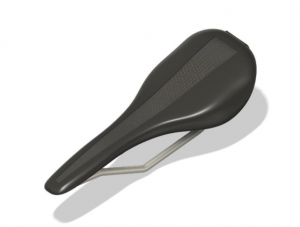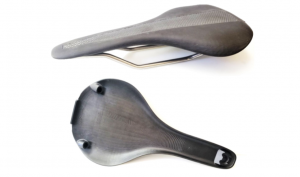Project Overview
Optimization of a part can change many details of the design. We will be looking at the design of a bike saddle. We have inherited this project from a graduate student who is working with a bicycle company and the kinesiology department to optimize the bike saddle design. The goal is to make the saddle as light as possible while being comfortable to the rider. The printed saddle will be combined with reinforcement material so it will remain rigid under the force of the rider’s weight.
Preliminary designs and manufacturing considerations
We will be using digital light synthesis (DLS) which uses a dual curing process of the resin. This will allow us to use a hybrid composite manufacturing process. The first cure of the resin only partially cures it so once the part is removed from the build platform, we can add carbon fiber reinforcement in the high stress areas. The second curing process will solidify the bond between the semi cured part and the carbon fiber reinforcement.
In order to optimize the design, we must study where the high stress concentrations are on the saddle. This experiment has been done before our team began this project. We will be using FEA in order to determine the areas where we can remove material and areas that need reinforcement. First, a CAD model will be developed that includes the carbon fiber reinforcement as structural components which will be included in FEA simulation. This has not been done for this project in the past. By including the carbon fiber in the simulation, it is expected that more accurate results may be obtained, and additional material may be removed further reducing the weight. Ideal locations for the carbon fiber reinforcement will also be investigated. Currently, only a very simple pattern is being used, and a more refined design may yield better results. There are a couple of variables to consider when running our analysis: the rider’s sitting position will influence the high stress areas and the rider’s gender will affect the comfortability of the design. Furthermore, our design must include the features that will allow it to be mounted. The geometry for the mounting design cannot be altered. All of these factors must be considered when designing our saddle and running the analysis. We have a previous design made by a former student which will be analyzed as a starting point for our design.

Figure 1: Previous bike saddle design [1]
 Figure 2: Features needed in order to mount the bike saddle [1]
Figure 2: Features needed in order to mount the bike saddle [1]
Proposed first print trial
Manufacturing composite structures with the DLS printer and carbon fiber prepreg is a multistep process. The base structure is first printed on the Carbon M1 printer, but at this state, it is not at full strength nor ready to be assembled with the carbon fiber support. Before assembly, the part must be partially cured with UV. After the UV cure, it is ready to be assembled with the carbon fiber. The carbon fiber is cut to size from flat sheets of prepreg. The partially cured part, and carbon fiber reinforcement are then assembled in a vacuum bag to ensure proper adhesion and minimal voids. Any lack or adhesion or inclusion of voids can lead to reduced mechanical properties. After assembly, the part is ready for final heat curing in an oven after which it is completed and ready for testing. All equipment necessary to manufacture a complete part will be supplied by the Polymer Engineering Center.
Once completed, the part will be evaluated for comfort, and, time permitting, experimentation may be conducted to characterize the mechanical properties and compare them to the predicted values from simulation. It is unlikely that there will be time for any significant experimentation, so a more detailed test plan has not yet been completed. If testing does become feasible, the team will work with Alec Redmann, the graduate student who originally proposed the project, to determine an adequate plan.
Sources
[1] Redmann, A. 2020. 3D Printed Hybrid Composite Structures. 30 March 2020 (accessed 28 February 2021)